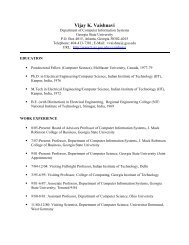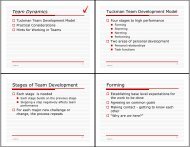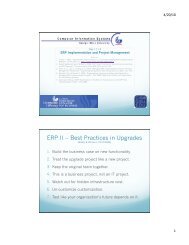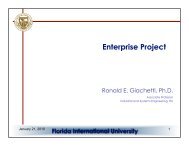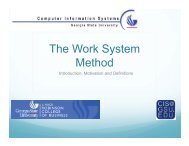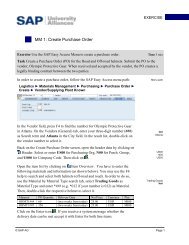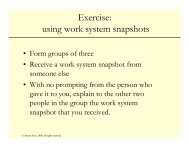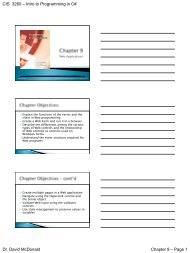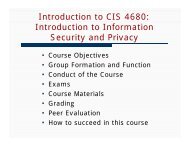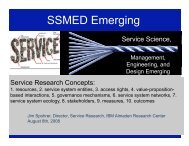The Work System Method - Department of Computer Information ...
The Work System Method - Department of Computer Information ...
The Work System Method - Department of Computer Information ...
Create successful ePaper yourself
Turn your PDF publications into a flip-book with our unique Google optimized e-Paper software.
the basic financial statements that defined benefit pension plans are required to provide, althoughadditional financial information may be provided. Furthermore, the Board concluded thatStatement 95 was not intended to modify the reporting requirements for those plans.16. Other employee benefit plans that are not covered by Statement 35, such as health andwelfare plans, may have characteristics similar to those <strong>of</strong> defined benefit pension plans and maypresent financial information similar to that required by Statement 35 (including the presentation<strong>of</strong> plan investments at fair value). <strong>The</strong> Board believes that those plans likewise should not berequired to provide a statement <strong>of</strong> cash flows.17. <strong>The</strong> Board does not prohibit the inclusion <strong>of</strong> a statement <strong>of</strong> cash flows with the annualfinancial statements <strong>of</strong> an employee benefit plan. In fact, the Board encourages plans to providea statement <strong>of</strong> cash flows when that statement would provide relevant information about theability <strong>of</strong> the plan to meet future obligations. For example, the Board believes that a statement<strong>of</strong> cash flows would provide relevant information about a plan's ability to meet future obligationswhen the plan invests in assets that are not highly liquid, such as real estate, or obtains financingfor its investments.Investment Companies18. Before the issuance <strong>of</strong> Statement 95, the Board considered whether investment companiesshould be required to provide a statement <strong>of</strong> cash flows as part <strong>of</strong> a full set <strong>of</strong> financialstatements. <strong>The</strong> Board recognized that information about the cash flows <strong>of</strong> certain investmentcompanies may be less important than similar information for other enterprises, but the Boarddecided that information about cash flows is relevant and that investment companies should notbe exempted from a requirement to provide a statement <strong>of</strong> cash flows.19. While the Board continues to believe that information about cash flows is relevant forinvestment companies, the Board readdressed the need for highly liquid investment companies toprovide a statement <strong>of</strong> cash flows under certain conditions. Highly liquid investment companiesare those whose assets consist predominantly <strong>of</strong> cash, securities, and other assets for which amarket is readily available. For example, open-end investment companies hold themselves outas being able to redeem their outstanding shares within seven days; therefore, they are requiredto maintain a portfolio <strong>of</strong> investments that enables them to fulfill that obligation.20. For highly liquid investment companies that do not finance investments with debt, theBoard concluded that the financial statements other than a statement <strong>of</strong> cash flows generallywould provide sufficient information for a user to assess the enterprises' liquidity, financialflexibility, pr<strong>of</strong>itability, and risk. However, for investment companies that invest in assets forwhich a market is not readily available or that finance investments with debt, the Board believesthat a statement <strong>of</strong> cash flows would provide relevant information about the enterprises'investing and financing activities to assist users in those assessments.Copyright © 1989, Financial Accounting Standards BoardNot for redistributionPage 11



